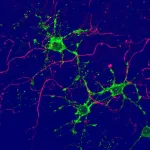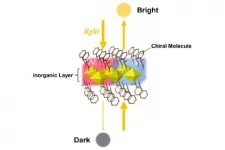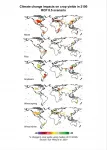(Press-News.org) A non-contact laser imaging system could help doctors diagnose and treat eye diseases that cause blindness much earlier than is now possible.
The new technology, developed by engineering researchers at the University of Waterloo, is designed to detect telltale signs of major blinding diseases in retinal blood and tissue that typically go unseen until it is too late.
With current testing methods, diseases such as age-related macular degeneration, diabetic retinopathy and glaucoma--which have no symptoms in their early stages--are usually diagnosed only after vision is irreversibly affected.
"We're optimistic that our technology, by providing functional details of the eye such as oxygen saturation and oxygen metabolism, may be able to play a critical role in early diagnosis and management of these blinding diseases," said Parsin Haji Reza, director of the PhotoMedicine Labs at Waterloo.
Patented technology at the core of the new system is known as photoacoustic remote sensing (PARS). It uses multicoloured lasers to almost instantly image human tissue without touching it.
When used for eyes, the non-invasive, non-contact approach dramatically improves both patient comfort and the accuracy of test results.
The technology is also being applied by Haji Reza and researchers in his lab to provide microscopic analyses of breast, gastroenterological, skin and other cancerous tissues, and to enable real-time imaging to guide surgeons during the removal of brain tumors.
"PARS may move us beyond the current gold standard in ophthalmological imaging," said Dr. Richard Weinstein, an ophthalmologist and co-founder of the Ocular Health Centre. "For the first time, not just in ophthalmology but in the entire medical field, diagnosis and treatment of disease could be made prior to structural change and functional loss."
Haji Reza, a professor of systems design engineering and co-founder of startup company illumiSonics, said researchers are working with several ophthalmologists and hope to start clinical trials within two years.
A paper on the research, Functional and structural ophthalmic imaging using noncontact multimodal photoacoustic remote sensing microscopy and optical coherence tomography, appears in the journal Scientific Reports.
The research team includes graduate students Zohreh Hosseinaee, Nicholas Pellegrino, Layla Khalili and Lyazzat Mukhangaliyeva, and research assistant Nima Abbassi.
INFORMATION:
PULLMAN, Wash. - Most consumers care about the technology and the ingredients used to make their microwavable dinners and other shelf ready meals, according to a new study led by Washington State University researchers. The study found that many consumers are willing to pay a premium for ready-to-eat meals with a 'clean label' showing few ingredients.
They are also more willing to fork out their hard-earned cash when they know their processed foods are made with a new technology that helps limit the number of additives and preservatives commonly found in most ...
Advancements in wearable technology are reshaping the way we live, work and play, and also how healthcare is delivered and received. Wearables that have weaved their way into everyday life include smart watches and wireless earphones, while in the healthcare setting, common devices include wearable injectors, electrocardiogram (ECG) monitoring patches, listening aids, and more.
A major pain point facing the use of these wearables is the issue of keeping these devices properly and conveniently powered. As the number of wearables one uses increases, the need to charge multiple ...
Neurons, nerve cells in the brain, are central players in brain function. However, a key role for glia, long considered support cells, is emerging. A research group at the University of Basel has now discovered two new types of glial cells in the brain, by unleashing adult stem cells from their quiescent state. These new types of glia may play an important role in brain plasticity and repair.
The brain is malleable well into adulthood. Brain plasticity is not only due to the formation of new nerve connections. Stem cells present in the adult brain also ...
Moreover, they identified a correlation between the progression of the disease and certain corpuscles in the cell nuclei. They published their report in the journal Acta Neuropathological Communications on 13 April 2021.
Aggregates seem to have a function
Affecting over 50 million people, Alzheimer's disease is the most common form of dementia and primarily occurs in people over the age of 65. The pathology of the disease in the brain is mainly characterised by two factors: beta-amyloid plaques outside the nerve cells and tau proteins. The tau protein stabilises tube-like structures (microtubules) inside cells, which are relevant ...
With Oskar Aszmann and his team at the Department of Plastic, Reconstructive and Aesthetic Surgery, MedUni Vienna has long been regarded as a world leader in bionic limb reconstruction. It was only last year that the world's first fully integrated bionic arm prosthesis was developed at MedUni Vienna. This is ready-to-use and is described as "Plug and Play". Although all bionic aids have so far been used in humans, the technique known as osseointegration (direct skeletal attachment) has now been used for the very first time in a bearded vulture - the creature was given a new foot. A paper on this ground-breaking procedure has been published today (Friday) in the prestigious Journal Scientific Reports.
In large birds such as vultures, the loss of limbs results in the ...
Researchers at Tohoku University have demonstrated the designability of novel magnets with magic mirror-like characteristics in organic-inorganic hybrid perovskite (OIHP)-type compounds.
OIHP-type compounds, a type of material used to construct solar cells, possess exceptional optical properties and have recently attracted worldwide interest. Researchers are keen to harness their structural diversity.
Although the superior optical properties of OIHPs have been mainly studied for their photoelectric characteristics, several OIHP-type compounds are known to function as magnets that transmit light. Combining the excellent optical ...
Not only the very concise 11-year cycle, but also all other periodic solar activity fluctuations can be clocked by planetary attractive forces. This is the conclusion drawn by Dr. Frank Stefani and his colleagues from the Institute of Fluid Dynamics at the Helmholtz-Zentrum Dresden-Rossendorf (HZDR) and from the Institute of Continuous Media Mechanics in Perm, Russia. With new model calculations, they are proposing a comprehensive explanation of all important known sun cycles for the first time. They also reveal the longest fluctuations in activity over thousands of years as a chaotic process. ...
On average the earliest memories that people can recall point back to when they were just two-and-a-half years old, a new study suggests.
The findings, published in peer-reviewed journal Memory, pushes back the previous conclusions of the average age of earliest memories by a whole year.
They are presented in a new 21-year study, which followed on from a review of already-existing data.
"When one's earliest memory occurs, it is a moving target rather than being a single static memory," explains childhood amnesia expert and lead author Dr Carole Peterson, from Memorial University of Newfoundland.
"Thus, what many people provide when asked for their earliest memory is not a boundary or watershed beginning, before which there are no memories. Rather, ...
Shifts in weather patterns induced by climate change will increase extreme heat and reduce rainfall across major crop growing regions, with impacts on agricultural production. Will this trigger a decline in the supply of calories needed to sustain the world's growing population?
According to a study published in the Journal of Environmental Economics and Management, global calorie supplies are subject to continuing or even increasing vulnerability to climate change. Climate change could reduce global crop yields by 10% by mid-century and 25% by century's end, under a vigorous warming scenario, if farmers cannot adapt better than they did historically. ...
Every day, around 15 000 children under the age of five die from causes that could have been prevented.
But the children of highly educated parents survive more often than others. This statistic applies worldwide, according to a newly published sweeping systematic review in The Lancet.
The mother's level of education is particularly important for her children's survival.
"One year of extra education for the mother is associated with an approximately three per cent reduction in mortality on average," says Professor Terje Andreas Eikemo at the Norwegian University of Science ...




